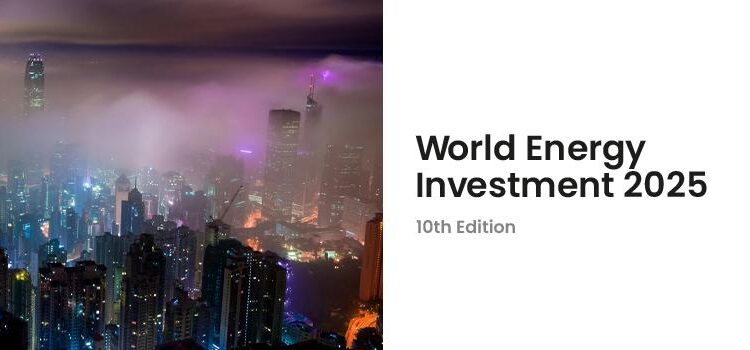The Future of Energy Investment: Insights for 2025 and Beyond
In the face of pressing issues like energy security and climate change, the International Energy Agency (IEA) has unveiled its significant report titled “World Energy Investment 2025 – Analysis.” This document offers vital perspectives on the evolving global energy sector. Amidst fluctuating fuel prices, geopolitical uncertainties, and a heightened focus on sustainability, this report presents groundbreaking forecasts and strategic guidance for policymakers and industry stakeholders. As investment trends shift dramatically due to technological innovations and regulatory changes, the IEA’s findings are crucial for navigating the intricate landscape of energy financing in the years ahead. With 2025 on the horizon, grasping these investment dynamics will be essential for fostering a sustainable and resilient energy future.
Investment Dynamics in the Energy Sector for 2025
As we near 2025, significant changes are reshaping energy investments driven by technological progressions alongside evolving regulatory environments. The IEA indicates a marked transition towards sustainable energy solutions as investors increasingly prioritize renewable resources over conventional fossil fuels. Notable trends include:
- Surge in Clean Technology Investments: Funding directed towards solar power, wind farms, and battery storage is anticipated to soar due to government incentives coupled with corporate pledges aimed at achieving net-zero emissions.
- Infrastructure Enhancement: Upgraded grid systems along with expanded electric vehicle charging networks are essential to meet rising green energy demands.
- Pursuit of Energy Efficiency: Investments focused on boosting efficiency across industrial operations and residential settings continue to gain momentum—yielding not only reduced emissions but also financial savings.
The financial landscape is also witnessing growing interest in hydrogen as an alternative form of energy carrier. Corporations alongside governments are delving into hydrogen initiatives recognizing its potential role in decarbonizing sectors that resist electrification efforts. Recent analyses predict a substantial increase in funding across various areas as illustrated below:
| Investment Focus Area |
Projected Investment by 2025 (Billion USD) |
| Sustainable Energy Sources |
$500 |
| Energy Efficiency Initiatives |
$200 |
<
Hydrogen Initiatives
|
$60
|
This shifting paradigm within the energy sector underscores not only an urgent need to combat climate change but also evolving views regarding both economic viability and security within this domain. Stakeholders must remain adaptable to leverage opportunities arising from this swift transition.
Renewable Energy Financing: Key Insights & Future Directions
The IEA’s latest findings emphasize an urgent requirement for robust financing within renewable energies if we aim to satisfy future demand effectively. As global investments funnel into transitioning technologies grow steadily, several critical trends have surfaced highlighting an immediate need for increased capital influx into this sector.
Main insights include:
- Booming Clean Project Financing:A notable rise in funding indicates a clear shift toward solar power generation facilities along with wind turbines paired with advanced battery technologies.
- Governmental Support :Policies from governments combined with international accords play pivotal roles mobilizing private sector investments .< / li >
- < b >Technological Innovations :Advancements related storage capabilities grid management systems expected enhance stability overall investment environment .< / li >
< / ul >
Despite these promising developments , challenges persist . The IEA cautions that while growth rates appear encouraging , they still fall short achieving overarching climate objectives globally . Additionally , volatile market conditions increasing competition among investors create obstacles particularly impacting emerging economies .< br />< br />
Pivotal focus areas moving forward should encompass :
- < b>Diversifying Financial Sources :Engaging institutional players development banks impact-focused funds broaden available financing options .< / li >
- < b>Tightening Regulatory Structures :Establish consistent supportive policies attract long-term commitments necessary secure sustained investments .< / li >
- < b>Cultivating Public-Private Collaborations :Fostering partnerships between governmental bodies private enterprises leverage shared expertise resources effectively tackle challenges together.< / li >
< / ul >
Guidelines For Policymakers And Investors Navigating The Transition In Energies
The roles played by policymakers investors prove crucial steering transitions occurring throughout global energies landscape effectively driving shifts requires prioritization strategies enhancing sustainability economic feasibility.
Investments directed towards renewables must align regulatory frameworks promoting innovation reducing barriers hindering entry new technologies markets while ensuring long-term commitments foster stability required developing infrastructures scaling clean solutions efficiently.
Key recommendations entail:< br />
- < strong >Encouraging Research Development : Create grant programs subsidies bolster innovative advancements related various forms energies technology sectors.< / li >
- < strong >Promoting Workforce Training Programs : Create educational initiatives equip individuals skills needed thrive green job markets today’s economy needs them most!< / li >
- < strong >Implementing Carbon Pricing Mechanisms : Create pricing structures reflecting true costs associated carbon emissions incentivize cleaner alternatives sources available now!< / li >
“For Investors understanding shifting dynamics surrounding current marketplace remains vital making informed decisions moving forward.” Transition low-carbon economies opens doors substantial returns especially sectors such as solar wind storage capabilities; thus diversifying portfolios mitigate risks tied traditional fossil fuel ventures becomes imperative too! Collaborations public entities yield impactful projects leveraging strengths both sides involved leading successful outcomes overall success stories abound here!” Noteworthy strategies include:< br />
* Diversifying Investments Across Emerging Markets: Explore opportunities presented through newer technologies renewable sources!*
* Pursuing Public Private Partnerships: Pool resources co-develop large-scale projects together!*
* *Utilizing Impact Investing Strategies Focus measurable benefits society environment alike!*
Looking Ahead To The Future Of Global Energies Landscape And Its Implications On Society At Large!
As we approach closer proximity toward year twenty twenty-five insights derived from International Agency’s analysis underscore critical juncture where current state affairs lie concerning worldwide systems governing our very own lifeblood—energy itself ! This report highlights pressing necessity ramp up support behind sustainable alternatives meeting ever-growing demands combating adverse effects stemming out climate change phenomena affecting us all collectively ! With renewables gaining traction whilst traditional fossil fuels facing scrutiny choices made today shape tomorrow’s landscapes profoundly impacting economic stability environmental sustainability globally speaking ! As stakeholders navigate through uncharted territories ahead imperative engage discussions collaborations ensuring alignment between market needs commitments set forth addressing concerns raised previously mentioned herein above!
No Result
View All Result
No Result
View All Result
|































